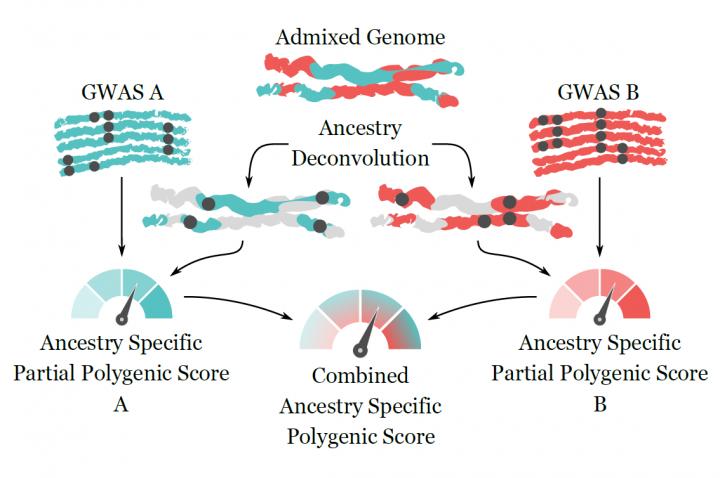Geneticists are bringing personal medicine closer to recently admixed individuals

The genome from an admixed individual (blue/red) is separated into the two main ancestral components (Ancestry Deconvolution). Mutations associated with diseases or phenotypic traits on each component (black dots) are studied separately and two Ancestry Specific Partial Polygenic Scores (A and B) are computed using information from population specific Genome Wide Association Studies (GWAS). The two Ancestry Specific Partial Polygenic Scores are then combined together to obtain the individual's Ancestry Specific Polygenic Score. Credit: Davide Marnetto
“The information contained in our DNA is a mosaic of genetic instructions inherited from our ancestors, and in many societies one's ancestors often come from the opposite corners of the world.” says Dr. Davide Marnetto, first author of the study.
The contribution of one's ancestry, or ancestries, to the total risk of developing a specific disease or presenting a given trait is a long standing question of medical genomics. Nevertheless, most of the genotype/phenotype association data come from relatively uniform populations, in order to have a simplified and clearer picture.
But what can be done when dealing with individuals who derive their ancestry from two or more distantly related populations?
“The latest developments of personalized medicine needed an extra step to be applied to individuals with more diverse origins, and here we tried to combine knowledge from homogeneous populations into a model that could work for recently admixed individuals” continues Dr. Marnetto.
To separate the various genomic components of each individual, Marnetto and colleagues applied methods from molecular anthropology and population genomics.
“This research is a welcomed example of deep synergy between evolutionary/population genetics framework and medically oriented large scale genomics science, which is one of the focuses of our institute.” says Dr. Mait Metspalu who is heading the institute of Genomics at the University of Tartu.
“Our work provides a solid proof of principle on the feasibility of using population genetic and molecular anthropology to boost the potential of personalized medicine. I hope our work can bring individuals of mixed ancestry one step closer to the benefits of personalized and predictive healthcare” concludes Dr. Luca Pagani, the research coordinator.
Media Contact
More Information:
http://dx.doi.org/10.1038/s41467-020-15464-wAll latest news from the category: Health and Medicine
This subject area encompasses research and studies in the field of human medicine.
Among the wide-ranging list of topics covered here are anesthesiology, anatomy, surgery, human genetics, hygiene and environmental medicine, internal medicine, neurology, pharmacology, physiology, urology and dental medicine.
Newest articles

Combatting disruptive ‘noise’ in quantum communication
In a significant milestone for quantum communication technology, an experiment has demonstrated how networks can be leveraged to combat disruptive ‘noise’ in quantum communications. The international effort led by researchers…

Stretchable quantum dot display
Intrinsically stretchable quantum dot-based light-emitting diodes achieved record-breaking performance. A team of South Korean scientists led by Professor KIM Dae-Hyeong of the Center for Nanoparticle Research within the Institute for…

Internet can achieve quantum speed with light saved as sound
Researchers at the University of Copenhagen’s Niels Bohr Institute have developed a new way to create quantum memory: A small drum can store data sent with light in its sonic…





















